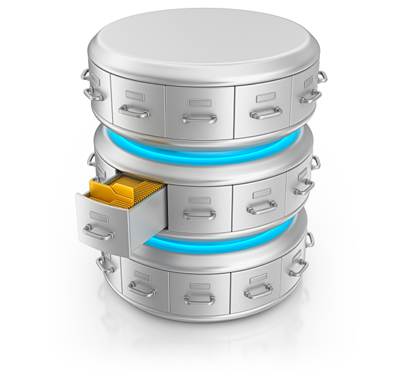The simplest implementation of database
Among all application software, the database may be the most complex.
MySQL’s manual has more than 3,000 pages, PostgreSQL’s manual has more than 2,000 pages, and Oracle’s manual is thicker than both of them combined.

However, it is not difficult to write the simplest database by yourself. There is a post on Reddit that explains the principle clearly in just a few hundred words. Below is what I compiled based on this post.
1. Save data in text form
The first step is to write the data you want to save into a text file. This text file is your database.
In order to facilitate reading, the data must be divided into records, and the length of each record is specified to be equal. For example, assuming that the length of each record is 800 bytes, the starting position of the fifth record is 3200 bytes.
Most of the time, we don’t know the position of a certain record, we only know the value of the primary key. At this time, in order to read the data, you can compare the records one by one. However, this is too inefficient. In practical applications, databases often use B-tree format to store data.
2. What is a B-tree?
To understand B-tree, we must start from the binary search tree.

Binary search tree is a data structure with very high search efficiency. It has three characteristics.
(1) Each node has at most two subtrees.
(2) The left subtree has a value less than the parent node, and the right subtree has a value greater than the parent node.
(3) To find the target value among n nodes, generally only log(n) comparisons are required.
The structure of the binary search tree is not suitable for databases because its search efficiency is related to the number of levels. The lower the data is, the more comparisons are needed. In extreme cases, n data requires n comparisons to find the target value. For the database, every time you enter a layer, you have to read data from the hard disk. This is very fatal, because the reading time of the hard disk is much longer than the data processing time. The fewer times the database reads the hard disk, the better.
The B-tree is an improvement on the binary search tree. Its design idea is to gather related data together as much as possible so that multiple data can be read at one time and the number of hard disk operations can be reduced.

B-tree also has three characteristics.
(1) A node can hold multiple values. For example, in the figure above, the largest node holds 4 values.
(2) New layers will not be added unless the data is already filled. In other words, B-tree pursues as few "layers" as possible.
(3) The value in the child node has a strict size correspondence with the value in the parent node. Generally speaking, if the parent node has a value, then there are a+1 child nodes. For example, in the picture above, the parent node has two values (7 and 16), which correspond to three child nodes. The first child node has a value less than 7, the last child node has a value greater than 16, and the middle child node It's a value between 7 and 16.
This data structure is very helpful in reducing the number of reads from the hard disk. Assuming that a node can hold 100 values, then a 3-layer B-tree can hold 1 million data. If it is replaced by a binary search tree, 20 layers are needed! Assuming that the operating system reads one node at a time and the root node remains in memory, then the B-tree only needs to read the hard disk twice to find the target value among 1 million pieces of data.
3. Index
The database is stored in B-tree format, which only solves the problem of searching data according to the "primary key". If you want to find other fields, you need to create an index.
The so-called index is a B-tree file with a certain field as the key. Suppose there is an "employee table" containing two fields: employee number (primary key) and name. An index file can be created for names. This file stores names in B-tree format, and each name is followed by its position in the database (i.e. which record). When searching for a name, first find the corresponding record from the index, and then read it from the table.
This index search method is called "Indexed Sequential Access Method", abbreviated as ISAM. It already has multiple implementations (such as C-ISAM library and D-ISAM library). As long as you use these code libraries, you can write the simplest database by yourself.
4. Advanced functions
After deploying the most basic data access (including indexing), some advanced functions can also be implemented.
(1) SQL language is a universal operating language for databases, so a SQL parser is needed to parse SQL commands into corresponding ISAM operations.
(2) Database connection (join) refers to the establishment of a connection relationship between two tables in the database through "foreign keys". You need to optimize this operation.
(3) Database transaction (transaction) refers to a series of database operations in batches. As long as one step fails, the entire operation will be unsuccessful. Therefore, it is necessary to have an "operation log" so that the operation can be rolled back when it fails.
(4) Backup mechanism: Save a copy of the database.
(5) Remote operation: Allows users to operate the database on different machines through TCP/IP protocol.

Hot AI Tools

Undresser.AI Undress
AI-powered app for creating realistic nude photos

AI Clothes Remover
Online AI tool for removing clothes from photos.

Undress AI Tool
Undress images for free

Clothoff.io
AI clothes remover

AI Hentai Generator
Generate AI Hentai for free.

Hot Article

Hot Tools

Notepad++7.3.1
Easy-to-use and free code editor

SublimeText3 Chinese version
Chinese version, very easy to use

Zend Studio 13.0.1
Powerful PHP integrated development environment

Dreamweaver CS6
Visual web development tools

SublimeText3 Mac version
God-level code editing software (SublimeText3)

Hot Topics
 How to use MySQL backup and restore in PHP?
Jun 03, 2024 pm 12:19 PM
How to use MySQL backup and restore in PHP?
Jun 03, 2024 pm 12:19 PM
Backing up and restoring a MySQL database in PHP can be achieved by following these steps: Back up the database: Use the mysqldump command to dump the database into a SQL file. Restore database: Use the mysql command to restore the database from SQL files.
 How to optimize MySQL query performance in PHP?
Jun 03, 2024 pm 08:11 PM
How to optimize MySQL query performance in PHP?
Jun 03, 2024 pm 08:11 PM
MySQL query performance can be optimized by building indexes that reduce lookup time from linear complexity to logarithmic complexity. Use PreparedStatements to prevent SQL injection and improve query performance. Limit query results and reduce the amount of data processed by the server. Optimize join queries, including using appropriate join types, creating indexes, and considering using subqueries. Analyze queries to identify bottlenecks; use caching to reduce database load; optimize PHP code to minimize overhead.
 How to insert data into a MySQL table using PHP?
Jun 02, 2024 pm 02:26 PM
How to insert data into a MySQL table using PHP?
Jun 02, 2024 pm 02:26 PM
How to insert data into MySQL table? Connect to the database: Use mysqli to establish a connection to the database. Prepare the SQL query: Write an INSERT statement to specify the columns and values to be inserted. Execute query: Use the query() method to execute the insertion query. If successful, a confirmation message will be output.
 How to create a MySQL table using PHP?
Jun 04, 2024 pm 01:57 PM
How to create a MySQL table using PHP?
Jun 04, 2024 pm 01:57 PM
Creating a MySQL table using PHP requires the following steps: Connect to the database. Create the database if it does not exist. Select a database. Create table. Execute the query. Close the connection.
 How to use MySQL stored procedures in PHP?
Jun 02, 2024 pm 02:13 PM
How to use MySQL stored procedures in PHP?
Jun 02, 2024 pm 02:13 PM
To use MySQL stored procedures in PHP: Use PDO or the MySQLi extension to connect to a MySQL database. Prepare the statement to call the stored procedure. Execute the stored procedure. Process the result set (if the stored procedure returns results). Close the database connection.
 How to fix mysql_native_password not loaded errors on MySQL 8.4
Dec 09, 2024 am 11:42 AM
How to fix mysql_native_password not loaded errors on MySQL 8.4
Dec 09, 2024 am 11:42 AM
One of the major changes introduced in MySQL 8.4 (the latest LTS release as of 2024) is that the "MySQL Native Password" plugin is no longer enabled by default. Further, MySQL 9.0 removes this plugin completely. This change affects PHP and other app
 iOS 18 adds a new 'Recovered' album function to retrieve lost or damaged photos
Jul 18, 2024 am 05:48 AM
iOS 18 adds a new 'Recovered' album function to retrieve lost or damaged photos
Jul 18, 2024 am 05:48 AM
Apple's latest releases of iOS18, iPadOS18 and macOS Sequoia systems have added an important feature to the Photos application, designed to help users easily recover photos and videos lost or damaged due to various reasons. The new feature introduces an album called "Recovered" in the Tools section of the Photos app that will automatically appear when a user has pictures or videos on their device that are not part of their photo library. The emergence of the "Recovered" album provides a solution for photos and videos lost due to database corruption, the camera application not saving to the photo library correctly, or a third-party application managing the photo library. Users only need a few simple steps
 Detailed tutorial on establishing a database connection using MySQLi in PHP
Jun 04, 2024 pm 01:42 PM
Detailed tutorial on establishing a database connection using MySQLi in PHP
Jun 04, 2024 pm 01:42 PM
How to use MySQLi to establish a database connection in PHP: Include MySQLi extension (require_once) Create connection function (functionconnect_to_db) Call connection function ($conn=connect_to_db()) Execute query ($result=$conn->query()) Close connection ( $conn->close())






